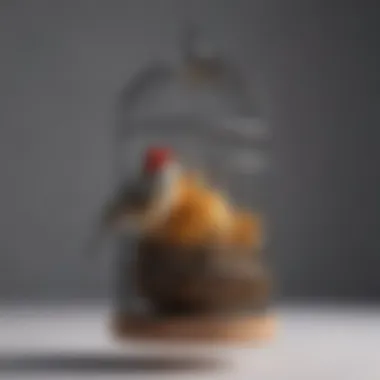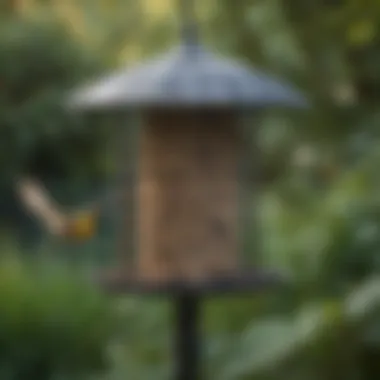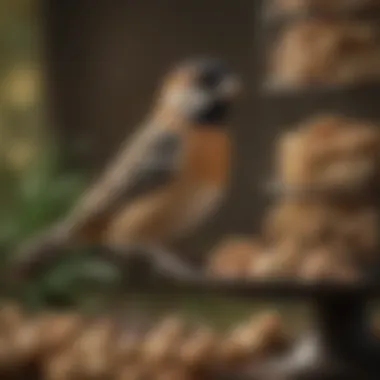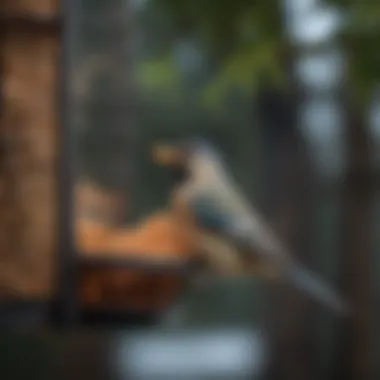Understanding Suet Feeders with Cages: A Detailed Guide


Intro
Suet feeders with cages serve as essential tools for fostering a vibrant backyard ecosystem. These devices allow pet bird owners and bird enthusiasts alike to provide high-quality nutrition while minimizing competition from larger species and unwanted animals. Understanding how to effectively utilize and maintain these feeders is crucial for ensuring that our avian friends receive their necessary diet and thrive in their environments. This guide delves into different aspects, illuminating the relevance of bird feeding practices and optimizing their wellbeing.
Care Tips
Daily Care Routines
Establishing a daily care routine for a suet feeder with a cage is vital. Check the feeder at least once a day to ensure that it remains filled with fresh suet. Inspect it for signs of spoilage, insect infestation, or decay. If you spot any issues, replace the suet immediately. Regular monitoring of the feeder helps maintain cleanliness and encourages birds to return regularly for feeding.
Cage Setup and Maintenance
Setting up a cage properly plays a huge role in attracting the right species. The cage should allow accessibility to various birds while protecting the suet from squirrels and larger animals. Regularly examine the cage for wear and tear. Tighten or replace any loose components to ensure it remains secure.
Hygiene and Cleaning Practices
Cleanliness is paramount in keeping both the feeder and birds healthy. Use a mixture of hot water and mild soap to wash the feeder every couple of weeks. Rinse thoroughly and allow it to dry before refilling. Also, disinfect the cage to prevent the spread of mites or fungus.
Seasonal Care Adjustments
As seasons shift, so too should your approach to caring for the suet feeder. In colder months, using suet formulated for higher energy conversion can attract birds that need more food. During warmer seasons, opting for suet with less fat content meets the dietary needs of species. Be mindful of temperature variations and adapt accordingly.
Behavioral Insights
Understanding Bird Body Language
A vital part of interacting with birds involves deciphering their body language. Observing tail movements, posture, and vocalizations can give insight into their comfort level and social dynamics. Understanding these cues allows for better feeding and interaction experiences.
Common Behavioral Issues and Solutions
Feeding from a suet feeder can sometimes lead to behavioral complexities. For instance, birds may exhibit aggression over food. If violence erupts among multiple species, consider a larger feeder or separate feeding spaces. Patience is crucial during these observations.
Positive Reinforcement Techniques
Encouraging consistent visitation can be aided through positive reinforcement. Bird enthusiasts can reward them by consistently providing food at specific times. Gradually, birds associate those times with reliable food availability.
Social Interaction Needs
Birds are social creatures that may act differently in the presence of others. Consider positioning the suet feeder where they can see other feeders and the general surroundings. This setup can foster a safe space and encourage healthy interaction.
Nutrition Guides
Essential Diet Components
A diversified diet is key hit for avian health. Look for suet blends that contain seeds, fruits, and nuts, as each component adds necessary protein, fat, and nutrients.
Safe and Toxic Foods
Familiarize yourself with what birds can eat safely. Stick to recommended products and consult lists from reputable sources regarding what's safe versus what's toxic.
Supplements and Treats
While suet is certainly vital, supplements can aid in providing complete nutrition. Products like powder supplements can amp up their daily intake, or occasional healthy treats can act as good motivators.
Feeding Strategies for Different Species
Understanding which birds frequent your garden is crucial for tailored suet provisioning. Species such as woodpeckers may prefer larger suet types, while smaller birds gravitate towards finely shredded arrangements. Adjust your feeding strategy based on visitors observed throughout the week.
Wellness and Health
Routine Health Checkups
Monitoring health should be part of routine care. Observe behavior, droppings, and maintained feather condition, indicating overall wellness. In case of any changes in activity levels, a veterinary assessment may be necessary.
Identifying Symptoms of Illness


Common symptoms to look for include lethargy, isolation, or changes in appetite. Spotting these early elements is crucial in seeking help before conditions worsen.
Preventative Care and Vaccinations
Consult vets experienced in avian care to schedule routine checkups or vaccinations. Taking advantage of these resources can enhance overall bird health.
Mental and Emotional Well-being
Birds also need mental stimulation. Offer interactive toys alongside regular feeding strategies to encourage both physical and emotional health.
Enriching Activities
Toys and Playtime Ideas
Giving birds entertaining environments can enrich their lives. Consider utilizing natural toys or providing various movement opportunities around the cage.
Training and Tricks
Spending time with your birds can foster more than just feeding trusts; it can lead to learning new tricks. Simple commands can enhance their skillset while building a bond between bird owners and their feathered friends.
Outdoor Activities and Interaction
Introduce safe, supervised outdoor interactions. Lifts cages or pens can provide a chance for birds to take in fresh air while ensuring safety.
DIY Projects for Mental Stimulation
Crafting simple toys or distractions at home promotes cognitive engagement. Alter and vary what is offered consistently to maintain their interest and combat boredom.
“A well-fed bird thrives; properly guiding feeding allows them to reach their potential, bringing joy to both bird and owner.”
This guide offers insights and a deep understanding, enabling bird enthusiasts to provide optimal conditions for their avian companions. For further information about different bird species and their needs, consult useful resources like Wikipedia, Britannica, and relevant communities on Reddit and Facebook.
Prelims to Suet Feeders
Suet feeders with cages provide a practical and effective solution for those passionate about supporting local bird populations. They are especially valuable during colder months when natural food resources become scarce. Understanding what these feeders are and their crucial role in avian nourishment is essential. This section introduces the significance of suet feeders and categorizes the first concepts that users need to grasp.
Understanding Suet and Its Benefits
Suet is a high-energy food source for a variety of bird species. Essentially composed of animal fat, suet offers macro-nutrients that help sustain birds, particularly when they need additional fat and energy, such as during winter. This fatty substance is also attractive to woodpeckers, nuthatches, and many other backyard birds.
Benefits of suet include:
- High Caloric Value: Suet provides the energy birds require to survive harsh weather conditions.
- Feeding Variety: Many suet cakes now include seeds, fruits, and nuts, appealing to multiple bird species.
- Encouragement of Diverse Avian Visits: When offering suet, one can attract not just common backyard birds but also rarer species.
Providing a balanced diet through suet lets bird owners witness the rich tapestry of bird behavior and interactions.
Why Choose a Feeder with Cage?
Opting for a suet feeder that has a cage introduces several advantages. A conventional suet feeder can be vulnerable to unwanted guests such as squirrels and raccoons, which may consume the food intended for birds. With a cage, typically formed from sturdy wire mesh, accessibility is limited to smaller avian visitors.
Key reasons for choosing a feeder with cage include:
- Protection from Larger Animals: A cage ensures that only birds can access the suet, keeping raccoons and rodents at bay.
- Preventing Food Waste: Since larger animals often cause spillage or take excess feed, a cage minimizes wasted food, ensuring that your birds benefit fully from the intended supply.
- Extended Durability: Many feeders with cages are built to withstand harsh weather conditions, promoting prolonged usage.
Ultimately, suet feeders with cages not only maintain an attractive feeding environment but also establish a safe space for birds to nourish themselves.
Components of a Suet Feeder with Cage
In understanding a suet feeder with a cage, one must appreciate several elements intertwining function and design. These components are essential for creating an efficient breeding ground for any bird owner seeking to support avian guests year-round. Key considerations encompass the materials used in construction and the specific design features that enhance usability while safeguarding the birds.
Materials Used in Construction
The choice of materials is paramount when selecting or constructing a suet feeder with a cage. Durable materials can ensure the longevity of the feeder while maintaining its effectiveness. Typically, one may find a combination of wood, metal, and recycled materials. Each has its specific merits:
- Wood: Commonly used for its aesthetic appeal, wood offers natural insulation and is less likely to overheat in direct sunlight. However, it may require regular maintenance to prevent rotting.
- Metal: Galvanized or stainless steel elements provide maximum durability. They resist weather elements and prevent tampering by squirrels or other critters.
- Recycled Materials: Environmentally friendly alternatives, often constructed from post-consumer plastics or other repurposed items, provide a lightweight and waterproof option that is easy to clean.
When sourcing materials, consider the potential for damage from moisture and critters. Selections employing weather-resistant properties are preferable. You'd want a feeder that withstands the elements for a prolonged lifespan while effectively serving its purpose.


Design Features of Effective Feeders
A good design is pivotal for bird feeders. Many features can turn a simple suet feeder into a reliable food source for birds. Effective designs often include:
- Caged Exteriors: Preventing larger birds or animals from consuming all suet is crucial. Cages allow smaller birds access while deterring unwelcome guests.
- Ventilation Holes: Proper airflow helps maintain the suet's freshness and prevents spoilage. A design with well-placed holes reduces trapped moisture buildup.
- Easy access for refilling: Feeders should be designed to remove and add suet easily. Look for mechanisms that do not require excessive troubleshooting.
- Hang or Stake Systems: Dependable hanging systems or ground stakes can enhance stability. Quality hangers or durable stakes reduce risk when hanging in windy conditions.
Every feeding station can vary in its elements, but considering efficiency informs better choices. A well-constructed suet feeder with a cage can attract a diverse avian community while remaining functional and accessible year-round.
Choosing the right materials and design features may ultimately determine the success of your feeding endeavors. A keen eye on the littlest details now can lead to birds flocking to your yard later.
Selecting the Right Suet Feeder
Choosing the right suet feeder plays a significant role in creating an effective feeding environment for birds. Not every suet feeder meets the specific needs of different bird species. This section outlines specific elements and benefits that should be considered when selecting a suet feeder, ensuring an optimal experience for both the birds and the feeder's user.
Size and Capacity Considerations
When evaluating size and capacity, think about how many birds you want to feed and the frequency of visits they make. Suet feeders can vary widely in dimensions and hold different amounts of suet. Larger feeders, while able to accommodate more suet, may also deter smaller birds. Careful selection should link the size of the feeder to the type of birds expected in your area.
Consider the following points when making your decision:
- Suet Block Weight: Standard suet blocks often weigh around 11-12 ounces. Select a feeder that can easily support this weight.
- Space for Feeding: Ensure the feeder has enough space to allow multiple birds to feed at once, promoting enjoyment and reducing territorial disputes.
- Feeder Design: Some feeders come with multiple compartments or a more open design, which can attract various bird species. This thoughtful feature can enhance your bird-watching experience.
Feeder Placement and Accessibility
Proper placement of your suet feeder is vital for maximizing bird visits and ensuring a comfortable experience for them. Birds look for feeders that are easy to access while also providing safety from potential predators. Where you place your suet feeder can significantly impact its effectiveness.
Focus on these considerations:
- Visibility: Choose a location where the feeder can be seen from a distance. This attracts more birds and encourages visiting.
- Shelter Nearby: Set the feeder close to trees or shrubs. Birds feel more secure with nearby cover but still crave a suitable launch point.
- Height and Ease of Access: Position the feeder within a convenient height range. Simply put, higher feeders may keep squirrels at bay but make it challenging for smaller birds who might not feel safe tackling those heights.
In summation, selecting the right suet feeder signifies more than mere preference. Multiple factors should culminate in aligning with the behavioral patterns and sizes of local birds. Taking these considerations into account can lead to a more effective and engaging bird feeding experience.
Installation Techniques for Suet Feeders
When it comes to utilizing a suet feeder effectively, understanding the installation techniques is crucial. Properly installing a suet feeder not only optimizes the feeding experience for birds but also ensures their safety and the longevity of the feeder itself. An effective installation can reduce issues related to leaning, wind tipping, and corruption from weather conditions.
Tools and Materials Needed
Before beginning the installation, you need specific tools and materials to make the process smoother. The following items will prove helpful:
- Screwdriver or Drill: Essential for fastening parts together securely.
- Screws or Hooks: Providing solid mounting options to the trees or poles.
- Tape Measure: Useful for measuring distances to ensure proper feeder height.
- Ladder: In case the chosen installation location requires some height to reach.
- Level: Ensures the feeder is balanced and won't swing or tilt.
It's also wise to have some weather-resistant materials. These will help the feeder withstand the elements like rain or strong winds.
Step-by-Step Installation Process
Understanding the installation process helps in avoiding common pitfalls associated with setting up a suet feeder. Follow these steps:
- Choose the Location: Identify a suitable location that offers birds some cover but is also visible. This could be near trees or shrubs.
- Measure the Height: Using tape measure, determine a height that is accessible for refilling but high enough to deter larger pests.
- Secure the Base: Using the screwdriver or drill, fix the screws or hooks securely into the chosen location – whether it's a tree or a faint post.
- Install the Feeder: Hang or mount the suet feeder onto the secured base. A level can be utilized at this point to ensure it sits evenly.
- Check for Movement: Check if the feeder sways or tilts. Adjust if necessary to guarantee stability against climatic forces.
- Final Adjustments: Upon completion of your setup, make sure that the feeder serves its purpose without unnecessary obstructions.
It is critical to observe that birds may prefer certain installations over others. Subtle qmvaraations in positioning can become significant factors in attracting or deterring local species.
Proper installation enhances the feeder's appeal and aids in attracting various birds while keeping them secure.
By following these outlined techniques, you will ensure a seamless integration of your suet feeder into the environment. Overall, ensuring that it's well placed will maximize visitor enjoyment for all denizens of your outdoor space.
Feeding Practices with Suet Feeders
Feeding practices play a central role in avian health and nutrition when using suet feeders. Understanding what to offer birds, and when, can create an inviting environment for them. Thoughtful selection and timing are essential for attracting various species while ensuring they receive the nutritional benefits from suet.
Types of Suet: What to Offer
Choosing the right type of suet is crucial for meeting the needs of different bird species. There are various options available, each catering to specific dietary preferences and energetic requirements of birds:
- Plain Suet: This is the basic form and usually consists of rendered animal fat. It is rich in calories and draws in woodpeckers, nuthatches, and chickadees.
- Suet Blends: These mixtures often include seeds, fruits, and nuts. They provide diverse nutrition, appealing to more species, including wrens and sparrows.
- Fruit-flavored Suet: Added flavors take the form of dried fruits like berry pieces or citrus. They may attract more of the insect-eating birds and those that delight in fruit.
- Insect-based Suet: This variant is suited for birds that have a natural inclination for insects during warm seasons. It often includes mealworms or dried insects.


Each type has its own merit, but local climate may dictate which choice is perfect during specific seasons. It is recommended to rotate between types, to keep visitors engaged and meet their dietary needs. A trade-up on variety will almost always improve visits from feathered friends.
Feeding Frequency and Timing
Feeding frequency can vary based on seasonal patterns and bird activity. Ideally, suet should be offered regularly, with daily checks to refill suet feeders when needed.
Morning and evening feedings are particularly effective. Birds are often most active during these times, seeking out nourishment. It is also prudent to adjust for colder months, refreshing feeders more frequently during hunting diving temperatures.
Considerations in feeding frequency:
- Adjustments based on the type of birds visiting.
- Seasonal variations affecting how much energy birds expend.
- Ensure cleanliness and hygiene when resupplying feeders.
In short, maintaining an effective feeding schedule combines species preference with seasonal factors to harmonize with bird activity levels. This way, suet feeders become reliable food sources for avians, supporting both their nutritional requirements and broader ecological health. Furthermore, keeping track of feeding routines encourages responsible bird feeding, making it an enriching experience for both the feeder and the fed.
Maintaining Your Suet Feeder
Maintaining your suet feeder is critical for several reasons. Regular upkeep ensures that the feeder remains functional, appealing to a variety of birds while also promoting their health. For suet feeders with cages, semi-annual maintenance not only prolongs its life but also minimizes health risks for the feathered visitors. Clean feeders translate to healthier habitats, as they reduce chances for disease that could affect wild populations and resident birds.
Cleaning Protocols and Hygiene
Regular cleaning of your suet feeder cannot be overstated. A dirty feeder harbors bacteria, mold, or fungi that can endanger birds. Here’s a step-by-step guide to cleaning:
- Remove leftover suet: Start by emptying any old or hardened suet.
- Scrub thoroughly: Use a brush or cloth with soapy water to scrub the feeder’s surfaces. Pay close attention to corners and crevices.
- Rinse well: Rinse the feeder with hot water to ensure all soap residue is removed.
- Disinfect: Occasionally use a diluted vinegar solution or a mild bleach solution (1 part bleach to 9 parts water) to disinfect before rinsing again.
- Dry completely: Let it air dry before adding fresh suet.
By cleaning regularly, you build a safe feeding environment, encouraging our feathered friends to return.
Inspecting for Wear and Tear
When maintaining a suet feeder, inspect it periodically for wear and tear. Most feeders experience some level of deterioration due to outdoor elements and regular use. Here are a few areas to check:
- Cage integrity: Look for gaps or broken bars in the feender's cage that could allow larger birds or predators to enter.
- Material degradation: Check wooden components for rot or cracks. Plastic parts can become brittle when exposed to sunlight.
- Small openings: Ensure that there are no jagged edges or sharp areas that could harm the birds.
Prompt attention to these issues aids in preventing further damage or risks to birds. Addressing minor repairs early contributes to a well-functioning feeder long-term.
It is crucial to create a safe and nourishing feeding experience to support bird health and visitation frequency.
Safety Considerations for Birds
Understanding safety considerations is critical when using suet feeders, as they directly influence bird well-being. Providing a safe feeding environment not only ensures the health of birds but also enhances their feeding experience. Key factors include contamination prevention and protection from predators.
Preventing Contamination
Contamination can pose serious health risks for birds. Spoiled suet, dirty feeders, and trapped debris are common culprits. Maintaining sanitation will keep birds safe from diseases. Regular cleaning is essential because moldy food can make birds ill. Best practices include:
- Wash feeders with warm, soapy water every two to three weeks.
- Select high-quality suet free from artificial ingredients. Check for expiration dates frequently.
- To reduce waste, only fill feeders enough to be consumed within a few days.
It is important to be vigilant. Monitor conditions closely, and ensure the food remains in pristine state. Mold or rancid suet can seriously harm the birds you wish to nourish.
Protecting Birds from Predators
Predator threats are an inherent risk in feeding birds. Natural hunters, like cats and hawks, can disrupt feeding time if the feeder lacks the proper design. Enhancing bird safety is crucial in creating a secure feeding environment. Effective strategies include:
- Mount feeders high, preferably more than five feet off the ground, to make access challenging for ground predators.
- Use feeders with solid, protective cages that can deter larger predators. They serve as a barrier between suet and dangers.
- Position feeders in safe zones, away from shrubs or areas where predators hide and lurk.
Ensuring bird safety requires consideration of their surrounding habitat. Careful feeder placement is just as important as the feeder itself.
Ultimately, the goal is a balance between attracting birds and protecting them. This makes for a sustainable and rewarding bird feeding practice.
The End: Enhancing Avian Feeding Experiences
Feeding birds is a satisfying practice that benefits both avians and feeder owners. Suet feeders with cages stand out as valuable tools for bird enthusiasts. They not only provide nutritional food but also create an environment that can be custom-designed to attract various species. Understanding their utility helps optimize feeding experiences, allowing for a deeper connection with local wildlife.
Summary of Key Takeaways
- Durability and Safety: Suet feeders with cages are often crafted from high-quality materials that resist weather effects. This durability ensures a long-lasting relationship with feathered guests. The cage design minimizes contamination and protects from pests.
- Diverse Options: Suet types are plentiful. Different blends attract diverse species, encouraging delightful interactions with nature. From fruit and nut combinations to traditional beef fat recipes, there is a snack for every taste.
- Installation Improvement: Proper installation of feeders in safe and accessible locations can immensely increase feeding traffic. Consider placement that is sheltered yet visible to birds. This encourages involved observations from the feeder owner.
- Maintenance Importance: Regular cleaning ensures hygiene and safe feeding. Materials left unattended not only deter avian visitors but can also jeopardize their health. Instituting a cleaning protocol is essential.
Encouraging Responsible Bird Feeding Practices
Responsible bird feeding is more than just filling a feeder. It requires consideration towards the birds and their environments. Here are some important points:
- Avoiding Overfeeding: Assess food needs for maintaining bird health. Overfilling can lead to wasted food and bigger messes.
- Seasonal Awareness: Feeding practices should adapt according to the seasons. Winter may require higher fat content, while spring can include more protein-rich blends.
- Assessing Visitor Needs: Not all birds prefer suet. Ensure offerings accommodate various species to sustain an inviting feeder. Using moth-balls or nontoxic species-attracting agents can make a difference.
- Community Education: Engage with local communities, encouraging responsible feeding practices will enhance avian appreciation at a larger scale. Knowledge shared empowers more people to engage consciencefully with feathered friends.
By implementing these practices and insights, not only do we enhance feeding experiences, but we also contribute to the well-being of the bird community. In this way, the act of bird feeding evolves from simple enjoyment into a vital part of local wildlife conservation.















